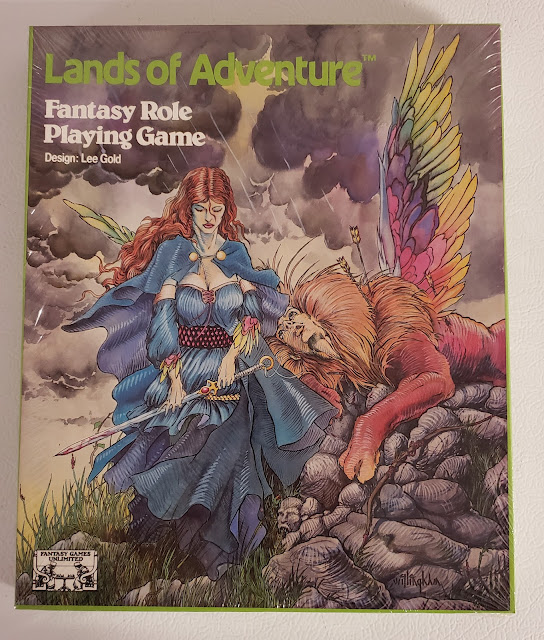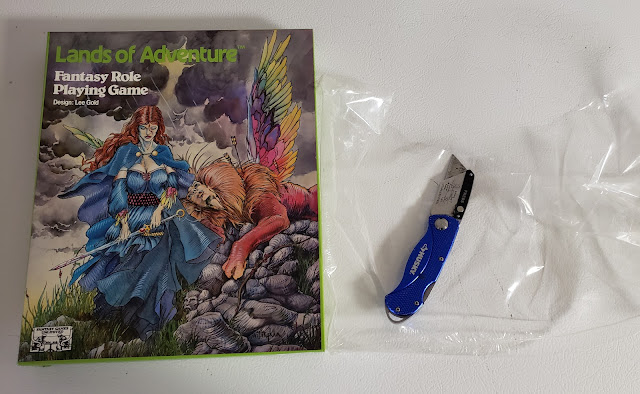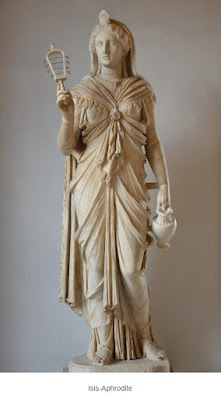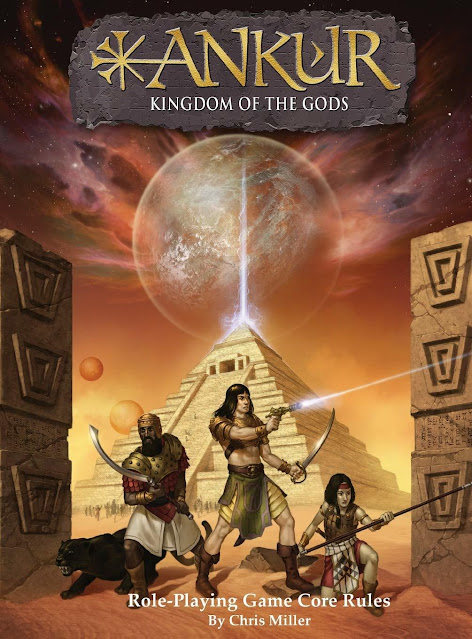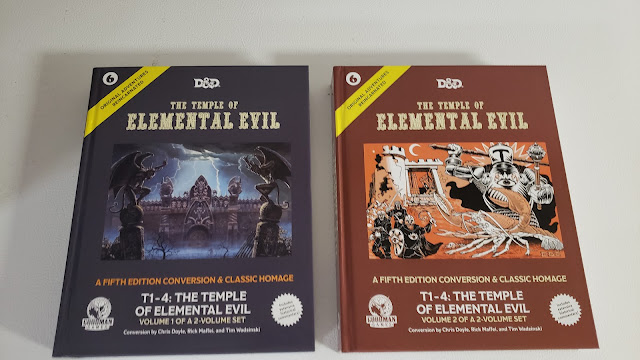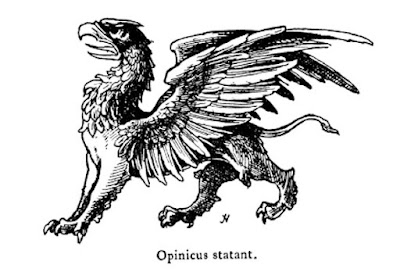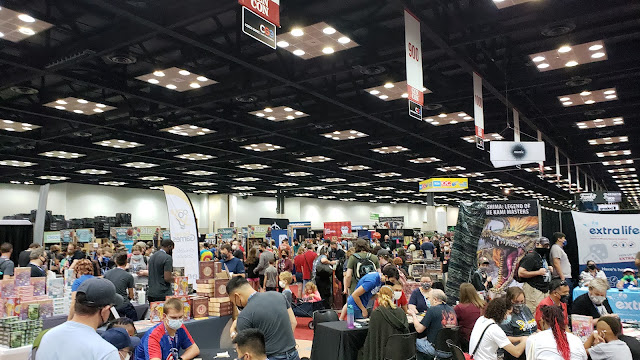Lands of Adventure has always been something of a Holy Grail item for me. I knew very little about the game and much less about the author and designer Lee Gold. However, the cover art was striking and different from anything else I had seen before that my curiosity only grew and grew. Later on, I began to learn who Lee Gold was and her contributions to the RPGs and geek/nerd culture in general, namely via Alarums and Excursions, that game went from a passing curiosity to an "it's on the list" item.
I am happy to report that not only is Alarums and Excursions still active, so is Lee Gold, having spoken with her briefly over the summer. After that my "it's on the list" item moved to the top of my list.
Circumstances seem to hit me just right. I had seen a huge increase in my sales and a shrink-wrapped copy had been offered for sale. I had the opportunity and I had the cash. The price might have been higher than I would have normally spent, but any buyer's remorse I might have had was quickly evaporated once I got this boxed in the mail and opened it up. I am not sure what my expectations were, it had been "on the list" for so long, but now I have it and I am really thrilled with it.
Lands of Adventure (1983)
Lands of Adventure by Lee Gold was published by Fantasy Games Unlimited in 1983. The boxed set came with the Lands of Adventure Rule Book (32 pages) and a Culture Pack (28 pages) that cover Mythic Greece and Medieval England. The back cover of the rule book has a character sheet. example and the box came with one character sheet on heavy paper/light card stock that can be copied. Which I did.
The box also included some "micro dice" two d20s (white and green) and two d6s (green, with pips). The d20s are numbered 0-9, 0-9, so good for d20s or d%s. I say good for them, but in truth, they are too tiny for me to read anymore! So I am going to dig up some others to use.
The books show their wargaming roots with sections numbered as 1.0, 1.1 all the way to 28.1. The Culture Pack follows suit, but the numbers here are tied to core rules. So section 1.1 of the culture section refers also to section 1.1 of the core rules. The Culture Pack section are prefaced with a code letter, which I discuss below.
Note on the art. The cover art for the box and the books is all done by Bill Willingham and it is some of the best art I have seen of his. I do believe it is one of the best covers for a game I have seen. Certainly, it was the best cover of the time. The book covers are no less impressive for their old-school black and white.
Seriously, that medusa is 10x better than any medusa art I have seen in D&D. The interior art is by Michael Kucharski. His art is good, though not at the level of the covers. Note. Both artists have websites and both artists have, since this book, gotten to be fantastic artists. Both also did their own versions of Doctor Stange[BW, MK], so maybe I need to roll up a Doctor Strange-like character for this.
In all cases, the art fits well with the books and the content.
Core Rules
The rulebook begins with a word from the author. Of note Gold mentions using The Palladium Book of Weapons & Armour, Through Dungeons Deep: A Fantasy Gamers' Handbook, and encyclopedias of animals.
Character creation is the big piece of the first book with 11 (yes Eleven!) character attribute traits, though only about half of those are random. The others are derived. The pure random characteristics are Craft, Talent, Appearance, and Strength. Derived characteristics are Dexterity, Voice, Intelligence, Prudence, Agility, Constitution, and Charisma. So more than D&D, but far less than DragonRaid. You can also determine Gender and Height.
Typically the traits are 1-20 which makes it good for converting on a d20 roll or a d% roll. Alternately there is a point-buy system where you can distribute 110+2d10 points across all 11. I'd likely stick to the derived ones and use the points to build the completely random ones. In this way, it is not all that different to say WitchCraft. Instead of 110+2d10, maybe 45+1d10 or something for the purely random ones (range: 4-80) and derive the others as normal.
Other details include the Culture Technology Level and modification due to races other than the default human are given.
Up next (1.1) is Piety. Various actions are given that adjust this score either through pious or blasphemous actions. This aids in forms of magic.
2.0 covers measuring Vitality. For the people that really enjoy complexity in their combat there three types of "hit points" in use in this game. They are Energy Points (EP), Body Points (BP), and Life Points (LP). EPs are lost due to magic or extra actions, BPs cover injury, and LPs cover grievous injuries. Body Points are increased by armor as described later in the armor section.
3.0 Introduces the Skill systems. The characteristics above determine skills, which are the meat of the game really. There are 10 skill categories with some specialist skills. These include Communication, Knowledge, Magic, Manipulation, Miracle, Movement, Observation, Persuasion, Weapons (Melee), and Weapons (Missile). Each has its own method of calculation. Skill checks are % and roll under. A roll of 1 to 10 is considered a Maximum success and considered flawless. A roll of 96 to 100 is a Fumble.
Specialized skills are well, pretty much that. But for every 10% increase in a Specialized skill, there is a +1% increase to the category. I have not seen that before. Categories though are Hard, Normal, Easy, and by Weapon. So improvement in say use of a sword by 10% your ability to shoot arrows increases by 1%. There is a rough logic here. Categories determine how long it takes to learn a skill and how they can improve.
The next sections cover all the skills and their specialties. For example, in section 6.0 we learn there are four categories of Magic; Compulsions, Illusions, Enhancements, and Energy. Section 8.0 Miracles is set up in a similar manner.
Section 12 covers our weapons and how to use them. Section 13 covers defense. Relating combat as skill is of course a feature of many games outside of the D&D world. Section 14 covers equipment.
Section 15 covers time. 1 Phase = 2 seconds, 1 round = 12 seconds (6 phases), and 1 minute = 5 rounds (30 phases). Skill time is measured in phases and rounds.
Section 17 covers magic in more detail, where Section 6 just details magic as a skill. There are no "spells" as in D&D per se (see below), but how much power it takes to perform certain example feats of magic. It reminds me a bit of what we would much later get in White Wolf's Mage or Eden's WitchCraft. In 17.9 some examples of "spells" built with the rules above are given. Section 18 covers spellcasting. Doing a Doctor Strange character is making more and more sense. Much like we will see later on in games like Mage, the four categories of magic can be combined in different permutations to make different spell effects.
Section 19 covers all sorts of Daemons, Demons, and Gods. This is followed quickly Section 20 on Miracles which is given similar coverage that Spells received. Section 21 gives us Thaumaturgists or mages with quasi-priestly powers. Section 22 likewise gives us Diabolists. Miracles rely on the beings from Section 19 to work.
Section 23 covers the basic stats for animals. Section 24 does the same for humanoids, 25 for Dragons, and 26 for types of undead. None of these sections have the detail as one would see in a monster manual, the assumption being that you would create your own monsters or rely on the Culture Packs.
We end with a very complete index.
The rules feel incomplete to be sure, but I am certain there is a playable game here. I might be mentally filling in the blanks of what is missing with knowledge of other games and what they would do.
Culture Pack
The intent of the Culture Packs was to provide a "Game" world for the characters to play in. While not specifically addressed, the assumption was I felt that these would be separate. Separated by time as they are in the real world. This is different than the take of Man, Myth & Magic which has all of the Mytho-Historical worlds existing together. There is a bit higher level of scholarship in our two worlds than what is typically seen in say Man, Myth & Magic.
It is explicitly stated that there would be more Culture Packs, but sadly no others were made. I could easily see Viking Age Northmen, Knights of Charlemagne, the Roman Empire, and Edo Period Japan. In fact, given Ms. Gold's previous game, Land of the Rising Sun, Edo Japan seems like an easy choice. I might have to have a look as Land of the Rising Sun and see if I can divorce it enough from Chivalry & Sorcery roots to make a "Culture Pack" for it. Gold would go on to write the GURPS Japan supplement. Likewise, the Viking era also seems like a given the Vikings game she did for I.C.E. later on.
This Culture Pack covers Mythic Greece and Medieval England. With each getting half the book.
Layout-wise the two sections follow the same pattern and the pattern set up in the Core Rules. As mentioned the Section numbers match those of the Core book. "C" is used for Mythic Greece (see below) and "M" for Medieval England. So in the Core rules, 1.0 covers humans with 1.0b nonhumans (like Elves, Dwarves, Giants). Section C1.0b covers centaurs, giants, and various nymphs. Section M1.0b cover faeries and picts.
Mythic Greece is given the title "Children of the Gods," thus the "C" in the section numbering. I approve, I used the same title (though without knowledge of this book) for my own coverage of Greek myths and Classical witches in Children of the Gods. This Culture Pack covers Ancient Greece before the Trojan War. The rules here make subtle changes to the Core rules as well as some additions. The big feature here naturally is the inclusion of more gods, festivals, and other creatures.
Medieval England moves the action North and about 2,000 years or so in the future, about the time of the Fall of the Western Roman Empire in England or 1070 CE. Coverage is given for England of the time. So one of my favorite topics, the confrontations of Christianity and the "Old Religion" of Celtic Paganism. So tips are given for role-playing as well as various rule changes. The formula used here to build the Culture Packs is very effective. Had this game been more successful I would have loved to have seen more.
Interestingly enough, much like my own Children of the Gods did with her Mythic Greece, there are connections here between her Medieval England and my other Basic Witch book, The Craft of the Wise. The connections are pretty obvious. We were reading the same research at the time/from the time. We both went into the coverage of Greek Myths by Robert Graves. For Medieval England, there are certainly a lot of material she could have used, but she also picked a few that were also on my list like the works of Margaret Murry ("The Witch-Cult in Western Europe") and poets like Kipling. It makes me wonder how my own books might have been different if I had seen Lee Gold's interpretations first. As suspected the Magic sections cover witches, familiars, and coven casting. All of it is very much right out of Murray's books. I have to admit I was a touch surprised not to see Frazer's "The Golden Bough" in her list of research.
Afterword
Lee Gold is still very active in producing Alarums and Excursions and she still plays Lands of Adventure with her group. I spoke to her over the summer and she is fantastic.
The game does have a "collected notes" feel to it as other reviewers have mentioned. That doesn't detract from a very fascinating, if involved game. I am certain that with Gold as a Game Master it is all quite fluid and dynamic, first time GMs will be spending a lot of time looking up formulas and a lot of pre-game prep building monsters, NPCs and the like.
I paid quite a lot for this game in it's original shrink wrap and I have to say I am not disappointed. It is such a fascinating snapshot of one designer's passion. While this could be construed as a "vanity project" it is not overly so. Lee Gold is obviously a great game designer. The diamonds of this game though are still hidden under a lot of coal.
I hope to spend some more time with it soon.
Unboxing Pictures
It's rare I get something from the 1980s still in shrink. Let's take it in.
Links
- Wayne's Books Unboxing. Glad I watched this AFTER my review. We agreed on a lot of points. His box is pretty much exactly like mine.
- Coverage on Wayne's Books site.
- Review by faoladh at the Ongoing Campaign. We agree on a lot points, but I think I liked it better.
- Grognardia's interview with Lee Gold
- Meet the Woman Who by 1976 Was the Most Important Gamer in Roleplaying After Gary, DMDavid
- Voyages in Eternity: RPG Archive: Lands of Adventure










